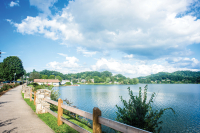Some things never get old
 Last Saturday (Nov. 3) was this year’s annual fall hike in the Waynesville watershed. The hikes started back in 2007, and I’ve been fortunate enough to be invited to tag along on most. The Waynesville watershed comprises nearly 8,600 acres, most of which are protected by conservation easements. The watershed is off limits to the public except for these annual (spring and fall) town sponsored hikes. The hikes are a way for town residents and other interested parties to get a glimpse of this wonderful resource that has been protected to insure the town has an ample supply of high-quality drinking water for generations to come.
Last Saturday (Nov. 3) was this year’s annual fall hike in the Waynesville watershed. The hikes started back in 2007, and I’ve been fortunate enough to be invited to tag along on most. The Waynesville watershed comprises nearly 8,600 acres, most of which are protected by conservation easements. The watershed is off limits to the public except for these annual (spring and fall) town sponsored hikes. The hikes are a way for town residents and other interested parties to get a glimpse of this wonderful resource that has been protected to insure the town has an ample supply of high-quality drinking water for generations to come.
We had hopes of providing a different hike route this fall — a trek down from the Blue Ridge Parkway — however, the inclement weather last week called for the closing of the parkway. But keep an eye on the Town of Waynesville’s website next spring as the option may be explored again.
But it doesn’t matter where you access the watershed from, once there you are immersed in an Appalachian forest story. It’s a story far too common across the Southern Appalachians — a story of merciless exploitation and the slash and burn timbering practices of the past. According to Dr. Pete Bates, natural resources professor, at Western Carolina University and original hike leader (and still one of the mainstays) for these watershed strolls, the Waynesville watershed has been heavily logged a number of times from the turn of the 20th century all the way up till the 1980s.
Because of heavy logging, fire suppression and the introduction of a host of invasive (plant and animal) species, the Waynesville watershed, like most forests across Western North Carolina, lacks the richness of diversity, structure and composition one would see in more pristine and/or better managed forests. Bates is the head of a team of researchers and natural resource managers who have developed the town’s watershed management plan. A plan devised to allow the forest to return to a more natural, more diverse, healthier ecosystem.
Now that’s not to say that the Waynesville watershed is not a beautiful, inviting, intriguing forest. In fact, Dr. Norm Christensen, founder of the Nicholas School of the Environment at Duke University and one of the researchers who assisted in the initial assessment of the watershed, told the Waynesville Watershed Advisory Board back in 2008 that the watershed forest was remarkably healthy and intact. He noted that the forest, like so many forests across WNC, was incredibly resilient despite, “… having the heck beat out of it.”
Related Items
He pointed to the “even-age” condition created by such heavy logging and off-site species like white pines and changes in natural forest communities brought about by the exclusion of fire as conditions that could be addressed through a sound, scientific forest management plan.
While part of the watershed hike is to point out some of the challenges facing the forest — the main point is to enjoy a great day afield in a forest that is working hard to heal itself. And that’s a pretty easy task.
The weather cooperated beautifully last Saturday with mild temperatures and clear skies. My group of “amblers” (we walk too slowly, smelling the flowers, counting the birds and turning rocks for salamanders to keep up with the “hikers”) had another wonderful day in the watershed. We were treated with good views of a couple of ruffed grouse that flushed and then flew alongside the van as we were being shuttled in to our starting point. We also got great looks at a pair of hermit thrushes dining on smilax berries.
The warm fall day provided a backdrop for at least five species of butterflies and five minutes streamside provided two species of salamanders. We also found a small stand of ladies’ tresses, spiranthes, in bloom and a hillside clump of witch hazel in bloom.
I always enjoy it when any group I’m leading on any kind of natural history walk kind of gets a collective “ah-ha” moment. We had crossed a creek and were walking the edge of a ridge, where the witch hazel was, when I stopped the group and told them to prepare for entering a different realm.
We rounded a corner and suddenly we were in one of the off-site white pine “plantations.” The understory, the diversity of tree species; the entire ecosystem had changed in just a few feet.
When these people hear talk about the need to thin white pine communities in Waynesville’s watershed, it will no longer be a statement — they will always have that essence, the knowledge of the difference between a native habitat and an introduced habitat. Sign up and come see it for yourself!
(Don Hendershot is a writer and naturalist. He can be reached a This email address is being protected from spambots. You need JavaScript enabled to view it..)









